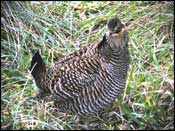A spring morning on the Texas coast was once greeted with the haunting sound of male Attwater’s prairie chickens calling from the short prairie grass.
Today the few remaining patches of Gulf Coast prairie are nearly silent.
In abundant numbers, Attwater’s prairie chickens once inhabited the tall grass coastal prairies from the coastal bend into Louisiana. But they have been slowly edged out by heavy grazing, farming and urban growth, as well as the spread of exotic invasive plants. Birds like the Attwater’s prairie chicken that depend on the prairie, have declined with the loss of habitat.
Today, this species, a bird which may have been the inspiration for Native American dances, is dependent on captive breeding programs for its continued survival. Biologists say if this bird is lost in Texas, there would be no other populations from which it could be restored.
“Without the efforts of the zoos that are breeding this bird for release, the population could not sustain itself,” said Mark Klym, Texas Parks and Wildlife Department’s coordinator of the Adopt-A-Prairie Chicken program.
“The Adopt-A-Prairie Chicken program is a great way for people to get involved directly in the effort to conserve this highly endangered bird,” Klym said. “Reintroduction programs must work hand in hand with habitat restoration programs. Fossil Rim Wildlife Center has certainly been a leader in the reintroduction efforts.”
Attwater’s prairie chickens hatched in zoos are released at the Attwater Prairie Chicken National Wildlife Refuge near Eagle Lake in Colorado County. There is also a population in Goliad County that was established with released birds from the zoos.
Concerned Texabs can help with a tax-free donation to the Adopt-a-Prairie Chicken program through Texas Parks and Wildlife Department. For more information see http://www.tpwd.state.tx.us/huntwild/wild/birding/apc/.


